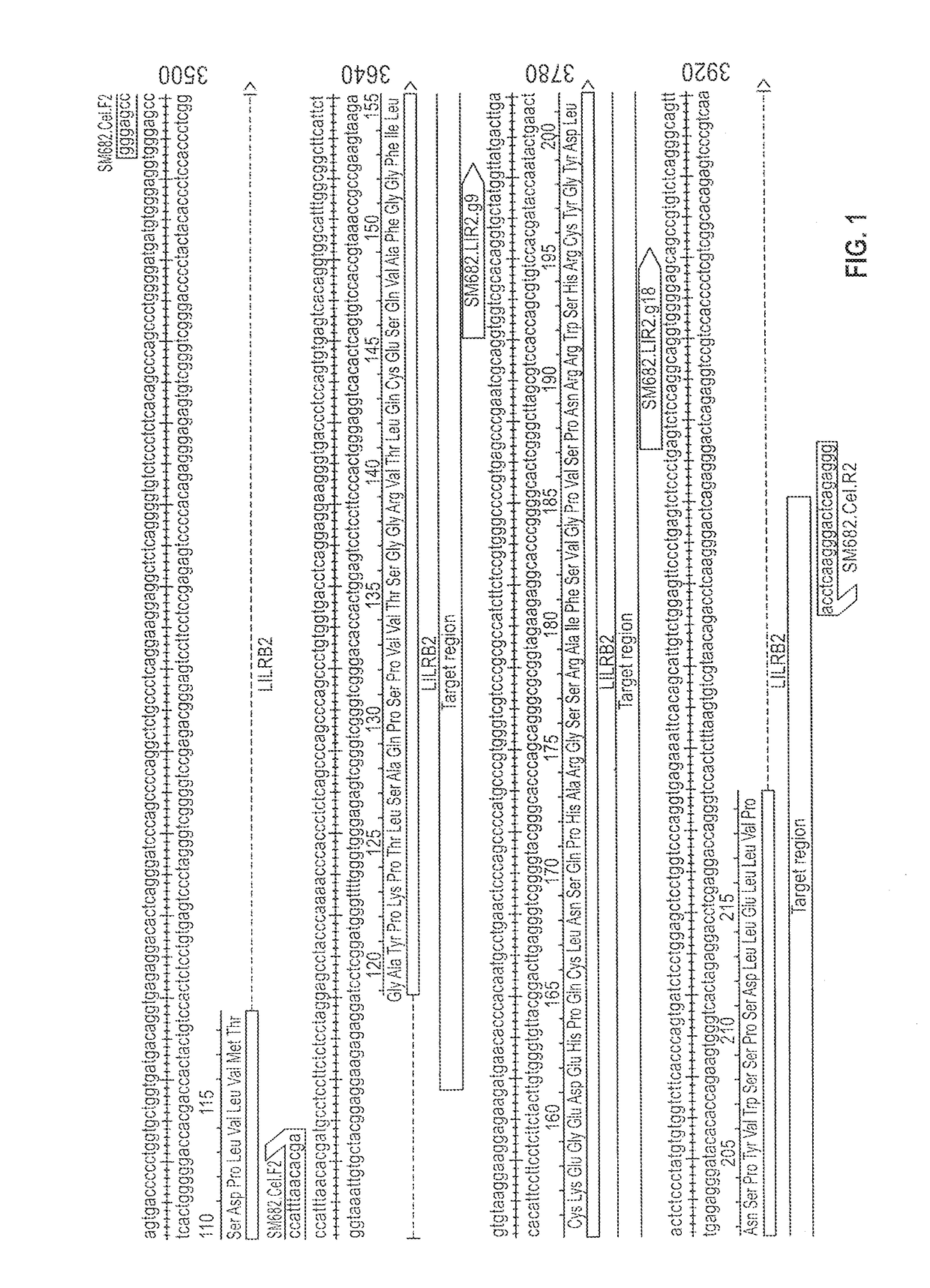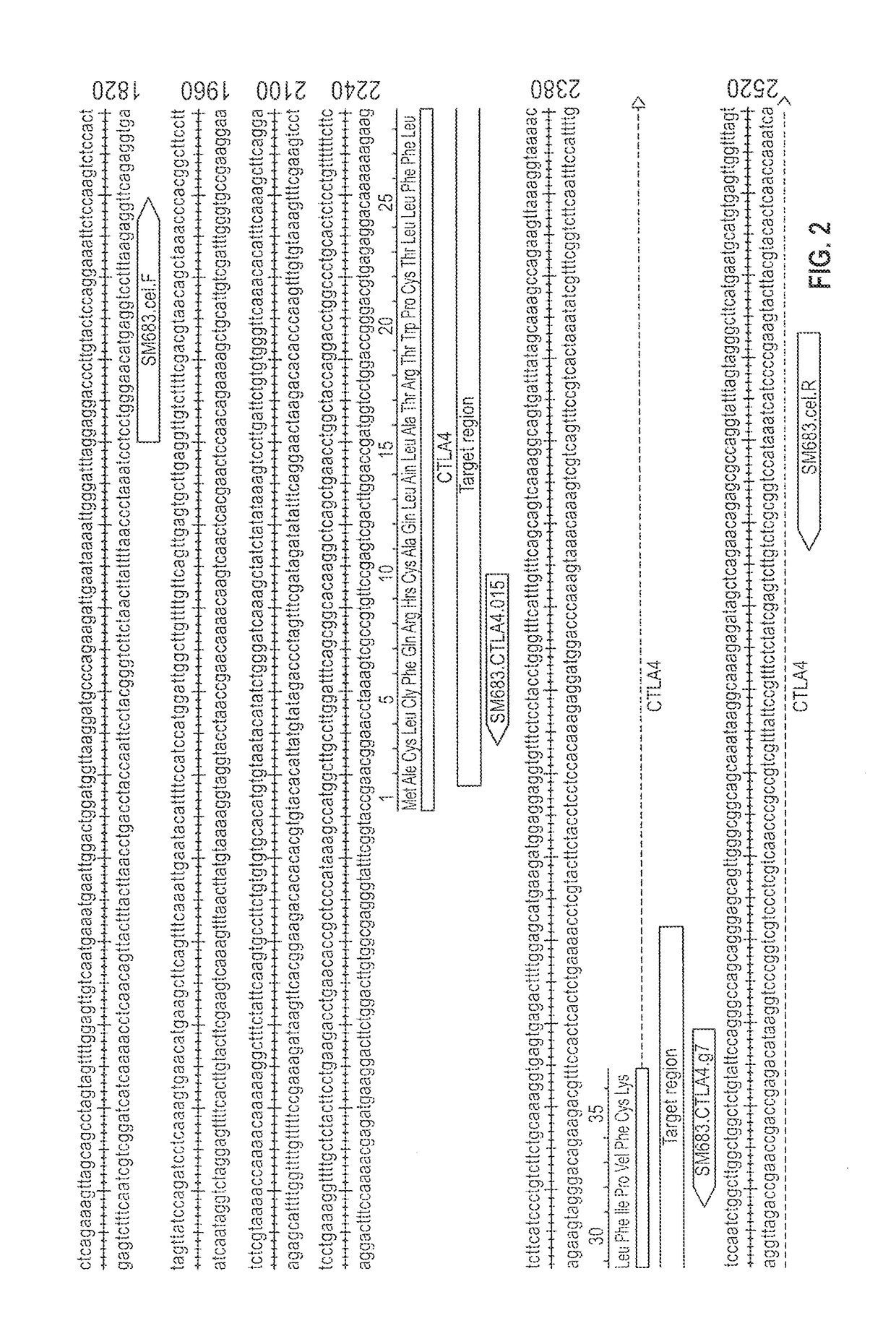Modified natural killer cells and natural killer cell lines having increased cytotoxicity
a technology of natural killer cells and cytotoxicity, which is applied in the direction of genetically modified cells, drug compositions, antibody medical ingredients, etc., can solve the problems of nkg2a expression decline, too trivial detection of cytotoxicity, and the death of the target cell, so as to increase the cytotoxicity of nkg2a expression, the normal cells in the body also become more susceptible to attack by modified nk cells
- Summary
- Abstract
- Description
- Claims
- Application Information
AI Technical Summary
Benefits of technology
Problems solved by technology
Method used
Image
Examples
example 1
of Inhibitory Receptor Function
CRISPR / Cas9
[0177]Cells were prepared as follows, having inhibitory receptor function removed. gRNA constructs were designed and prepared to target genes encoding the ‘classical’ inhibitory receptor LIR2 and the ‘checkpoint’ inhibitory receptor CTLA4 in the human genome of NK cells. CRISPR / Cas9 genome editing was then used to knock out the LIR2 and CTLA4 target genes.
[0178]Two gRNA candidates were selected for each target gene and their cleavage efficacies in K562 cells determined. The sequences of the gRNA candidates are shown in Table 1 and the Protospacer Adjacent Motif (PAM) relates to the last 3 bases of the sequence. The flanking regions of the gRNA sequences on the LIR2 gene (SEQ ID NO: 1) and the CTLA4 gene (SEQ ID NO: 7) are shown in FIGS. 1 and 2, respectively.
TABLE 1gRNA candidates and sequencesGenePlasmid NameSequencehLIR2SM682.LIR2.g9GAGTCACAGGTGGCATTTGGCGG(SEQ ID NO: 3)SM682.LIR2.g18CGAATCGCAGGTGGTCGCACAGG(SEQ ID NO: 4)hCTLA4SM683.CTLA4.g7...
example 2
of Checkpoint Inhibitory Receptor CD96 Function Via RNAi
[0212]siRNA knockdown of CD96 in KHYG-1 cells was performed by electroporation. The Nucleofection Kit T was used, in conjunction with the Amaxa Nucleofector II, from Lonza, as it is appropriate for use with cell lines and can successfully transfect both dividing and non-dividing cells and achieves transfection efficiencies of up to 90%.
[0213]Control siRNA (catalog number: sc-37007) and CD96 siRNA (catalog number: sc-45460) were obtained from Santa Cruz Biotechnology. Antibiotic-free RPMI-1640 containing 10% FBS, 2 mM L-glutamine was used for post-Nucleofection culture. Mouse anti-human CD96-APC (catalog number: 338409) was obtained from Biolegend for staining.
[0214]A 20 μM of siRNA stock solution was prepared. The lyophilized siRNA duplex was resuspended in 33 μl of the RNAse-free water (siRNA dilution buffer: sc-29527) to FITC-control / control-siRNA, in 165 μl of the RNAse-free water for the target gene siRNA (siRNA CD96).
[0215...
example 3
Cytotoxicity of NK Cells with a CD96 Knockdown
[0222]KHYG-1 cells with and without the CD96 knockdown were co-cultured with K562 cells at different effector:target (E:T) ratios.
[0223]Cytotoxicity was measured 4 hours after co-culture, using the DELFIA EuTDA Cytotoxicity Kit from PerkinElmer (Catalog number: AD0116).
[0224]Target cells K562 were cultivated in RPMI-1640 medium containing 10% FBS, 2 mM L-glutamine and antibiotics. 96-well V-bottom plates (catalog number: 83.3926) were bought from SARSTEDT. An Eppendorf centrifuge 5810R (with plate rotor) was used to spin down the plate. A VARIOSKAN FLASH (with ScanIt software 2.4.3) was used to measure the fluorescence signal produced by lysed K562 cells.
[0225]K562 cells were washed with culture medium and the number of cells adjusted to 1×106 cells / mL with culture medium. 2-4 mL of cells was added to 5 μl of BATDA reagent and incubated for 10 minutes at 37° C. Within the cell, the ester bonds are hydrolysed to form a hydrophilic ligand,...
PUM
| Property | Measurement | Unit |
|---|---|---|
| Affinity | aaaaa | aaaaa |
| Inhibition | aaaaa | aaaaa |
Abstract
Description
Claims
Application Information
 Login to View More
Login to View More - R&D
- Intellectual Property
- Life Sciences
- Materials
- Tech Scout
- Unparalleled Data Quality
- Higher Quality Content
- 60% Fewer Hallucinations
Browse by: Latest US Patents, China's latest patents, Technical Efficacy Thesaurus, Application Domain, Technology Topic, Popular Technical Reports.
© 2025 PatSnap. All rights reserved.Legal|Privacy policy|Modern Slavery Act Transparency Statement|Sitemap|About US| Contact US: help@patsnap.com



